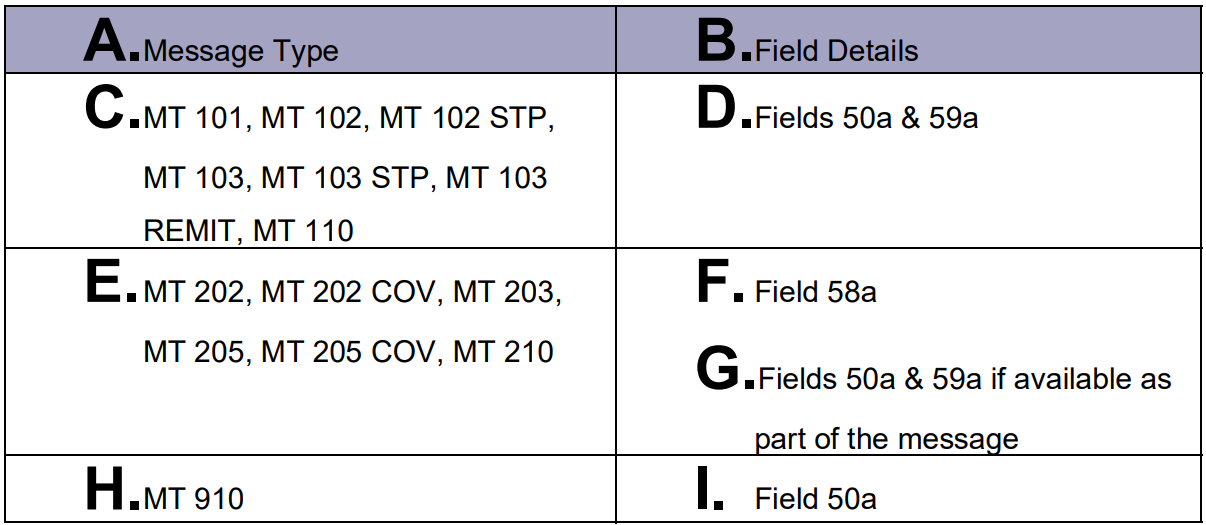Chinese Codeword Changes
Chinese character conversion are supported for both Cross Border/RTGS transactions. Chinese Character Conversion changes are maintained as part of Host Parameters screen (PMDHSTPR).
Chinese Character conversion supports both Simple Chinese and Traditional
Chinese.
- Static tables are provided for the CCC codes with Simplified Chinese and Traditional Chinese character conversion.
- Simplified Chinese or Traditional Chinese - System does a Chinese character replacement with CCC codes for outbound payment messages.
- For an inbound message, CCC codes are replaced with Chinese characters. The type of the character is defined by the Conversion preference at the host level.
- Chinese character replacement are applicable for the following list of fields /messages for both cross-border and RTGS:
Following are the conditions in which the system does not translate the Chinese
Character Conversion (CCC):
- Numbers consisting of more than four digits
- Example:59:50123 0224 1016
- Translated content in traditional Chinese (refer to CCC table): ‘50123? ? ’
- Translated content in simplified Chinese (refer to CCC table): ‘50123 俩堂 ’
- When having to quote a four-digit number in message formats, it is
recommended to put it between brackets, i.e., “(“and “)” or between quotes, i.e., “‘“to
trigger unintended conversion
- Example:59:(0123) 2435 3883
- Translated content in traditional Chinese (refer to CCC table): ‘(0123)? ? ’
- Translated content in simplified Chinese (refer to CCC table): ‘(0123) ? 环 ’
- A single CCC code is not allowed to span over 2 lines
- When a character other than a space is present between two CCC
- Example:59:0123-5188 0221
- Translated content in traditional Chinese (refer to CCC table):‘0123-5188 ? ’
- Translated content in simplified Chinese (refer to CCC table): ‘0123-5188 仓 ’
- Use ‘ADD.’ to separate two set of CCC code present in the beneficiary field.
- Field format of 59 (Beneficiary Customer) with two sub-fields
- [/34] optional account (sub-field 1)
- 4*35x Name and address (sub-field 2)
- In sub-field 2, after indicating the CCC code of the beneficiary name, put ‘ADD.’ followed by a space character. Immediately after that, the CCC codes of the address can be specified.Combining a three character Chinese beneficiary name, followed by the address on the same line and the address continuation on the following line
- Example:59:/123-123<CR>
- 1728 0001 0059 ADD.0554 0079 1579<CR>
- 6007 1004 0575 1630 4395 1129 5894
- Translated content in traditional Chinese (refer to CCC table):
- Name: ? ? ?
- Address: ? ? ? ? ? ? ? ? ? ?
- Combining a six character Chinese beneficiary name, which spans over more
than one line, followed by address
- Example:59:/123-124<CR>
- 0674 1778 0006 1351 0005 0934 ADD.<CR>
- 0554 0079 1579 6007 1004 0575 1630<CR>
- 4395 1129 5894
- Translated content in traditional Chinese (refer to CCC table):
- Name: 司徒上官三四
- Address: 北京市西城區幸福大街
- Since field 50F has a structured code for name (line begins with ‘1/’) and address (line begins with ‘2/’)in narrative text field, SWIFT standard is followed, instead of using ‘ADD’ to separate the name and address information.
- Example of how to represent the Chinese name and address of the ordering
customer in sub-field 2 of field 50F (Ordering Customer), using CCC codes:
- :50F:/NIDN/A1231247<CR> (National Identity Number)
- 1/0674 1778 0006 1351 0005 0934<CR>
- 2/0554 0079 1579 6007 1004 0575<CR>
- 2/1630 4395 1129 5894<CR>
- 3/CN/0022 0948
- Translated content in traditional Chinese (refer to CCC table)
- Name: 司徒上官三四
- Address: 北京市西城區幸福大街中國
Parent topic: Outbound Cross Border Payments View
